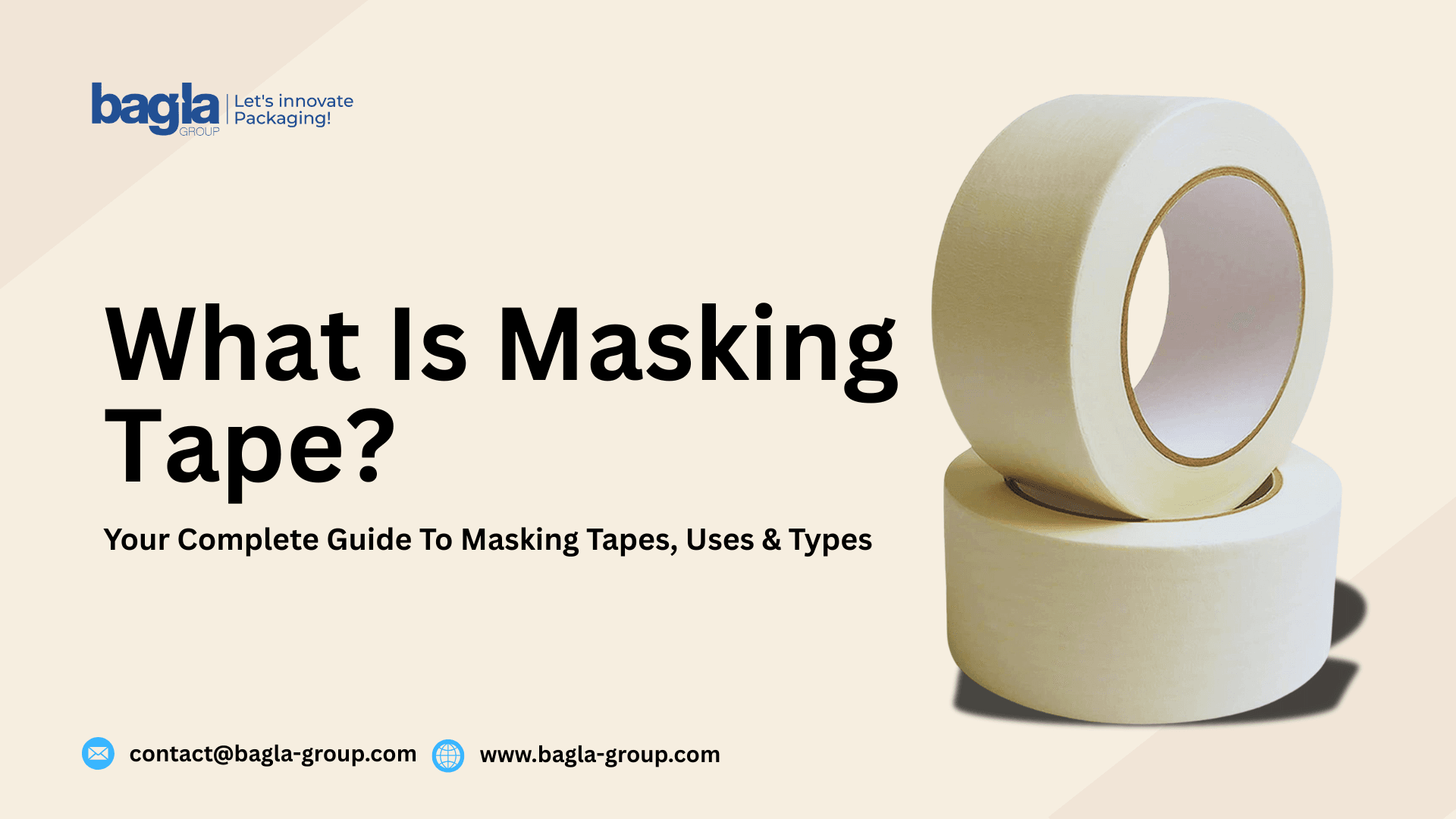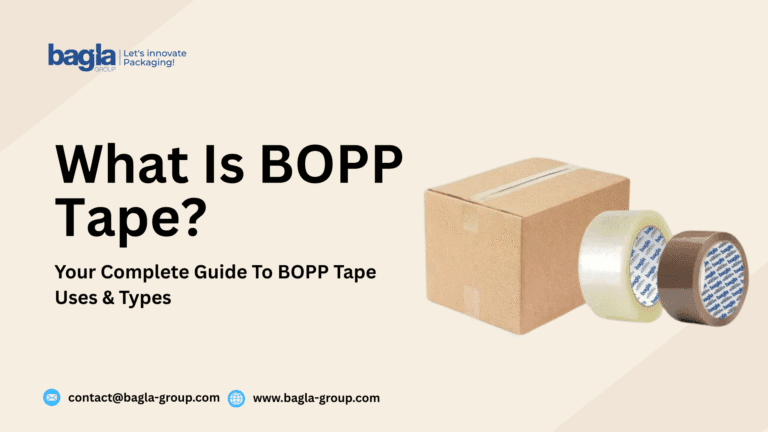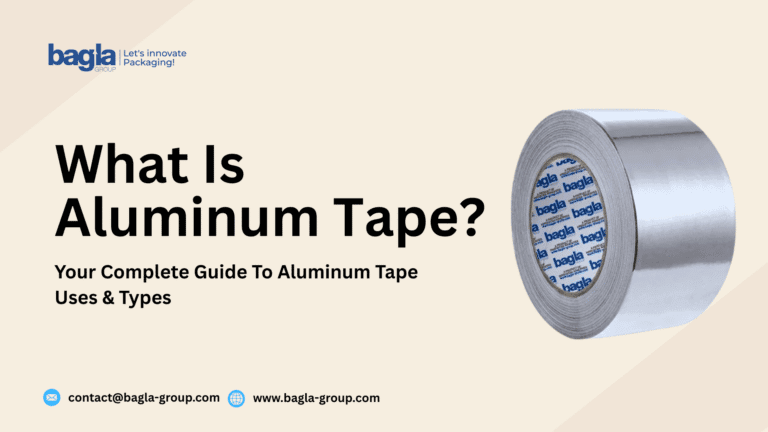For the painting, packaging, surface protection, or temporary holding, masking tape stands out as one of the most widely used and versatile products in both household and industrial settings.
But have you ever thought what exactly masking tape is? Why is it called that? Why is it a reliable choice in various industries?
In this blog, you will find answers to all your queries and learn the basics of masking tape.
What is Masking Tape?
Masking Tape is a pressure-sensitive adhesive tape. It is a reliable option for the temporary surface application. The tape is manufactured with light adhesive and an easy-to-tear paper backing. This will never leave sticky residue or damage after peeling off. This is designed to make it ideal for delicate applications such as painting, surface protection, and lightweight bonding.
Why Is It Called Masking Tape?
The name masking tape comes from its original and primary function to “Mask Off”. The tape is designed for those areas that you want to keep safe from the paint, glue, or other substances during a project.
What Are The Characteristics of Masking Tape?
Masking tape falls under the category of PSA (pressure-sensitive adhesive) tapes. This tape sticks with light pressure and does not require heat or water to activate the adhesive.
Key characteristics of masking tape include:
- Backing Material – Typically, crepe paper or flat-backed paper.
- Adhesive Type – Rubber-based, acrylic-based, or silicone-based, depending on the application.
- Adhesive Strength – Light to medium tack, with easy removal.
- Temperature Resistance – Basic masking tapes are suitable for indoor use, while industrial or automotive-grade tapes can withstand high temperatures (up to 200°C).
What Is Masking Tape Used For in Construction?
The masking tape plays an essential role in the construction industry. Here are the cases where you can use masking tape:
1. Surface Protection During Painting
Widely use tape in interior and exterior painting to create clean lines and crisp edges. Through this, you can create a masking off of adjacent surfaces. It ensures that only the intended area receives the paint.
2. Plastering and Drywall
It is a versatile choice for contractors before applying plastering and putty to cover electrical fixtures, window edges, or trim. This will simply avoid splatter and make cleanup much easier.
3. Marking and Labeling
Construction sites use masking tape to label tools, wires, or zones temporarily. The writable surface makes it easy to jot down instructions or directions.
4. Holding and Bundling
The teap is used for temporarily bundling light materials like pipes, wires, or wooden strips until permanent fixtures are added.
5. Protection from Dust or Debris
You can use this during the time of construction, such as taping off window sills, door frames, or HVAC vents to prevent dust or paint from accumulating in sensitive areas.
Difference Between Masking Tape and Masking Film:
| Feature | Masking Tape | Masking Film |
| Material | Paper-based tape | Plastic sheet |
| Usage | Edge masking, precision | Large area coverage |
| Adhesion | Built-in adhesive | No adhesive, held with tape |
| Flexibility | Good for narrow areas | Good for full-surface protection |
How is Masking Tape Used?
When you are using the masking tape effectively then it requires understanding of surface, adhesive strength, and the desired outcome. Here is the step-by-step guide to using tape properly:
1. Clean the Surface
Before applying, ensure that the area is dry and free from dust, grease, or loose particles. This will lead to improved adhesion and prevent peeling.
2. Choose the Right Tape
- Low-tack tape is the best for indoor painting.
- Choose UV-resistant or high-temperature masking tapes for exterior or industrial work.
- For delicate surfaces like wallpaper or freshly painted walls, go for delicate surface tape.
3. Apply the Tape
Roll the tape out steadily while pressing down with your fingers or a flat tool for an even seal. Avoid stretching tape as this can cause it to lift.
4. Remove at the Right Time
Once the task is complete, remove the masking tape slowly at a 45-degree angle before the paint fully dries to avoid chipping or tearing.
Types of Masking Tape (Based on Application)
Masking tapes are not one-size-fits-all. Different varieties are available for specific applications:
1. General Purpose Masking Tape
- Low cost
- Light-duty
- For temporary fixes, basic masking, and labeling
2. Painter’s Tape
- Specifically made for painting jobs
- Easy to remove without damaging the paint
- Available in multiple tack levels
3. High-Temperature Masking Tape
- Withstands temperatures up to 200°C or more
- Used in powder coating, automotive painting, or baking applications
4. UV-Resistant Tape
- Suitable for prolonged outdoor exposure
- Resists sun damage and adhesive degradation
5. Automotive Masking Tape
- Used in car body painting and detailing
- Resistant to solvents and high temperatures
Benefits of Using Masking Tape
1. Clean Removal
Leaves no residue if removed within the specified time limit.
2. Surface Safety
Does not damage most surfaces, including wood, metal, glass, and drywall.
3. Easy to Use
Tears by hand, making it a tool-free and time-saving solution.
4. Cost-Effective
Affordable and accessible in different widths and tack levels.
5. Customizable
Available in multiple colors for color-coding, labeling, or aesthetic contrast.
Factors to Consider While Buying Masking Tape
When you are choosing the masking tape for any project then you must keep these parameters in mind:
- Width – You must focus on the width of the tape; choose wider tape for larger surfaces and thinner tape for precision work.
- Adhesive Type – Rubber-based is more aggressive; acrylic-based lasts longer.
- Surface Type – Use delicate surface tape for painted or wallpapered surfaces.
- Time Duration – Check the “clean removal time” (e.g., 1-day, 7-day, or 14-day tapes).
- Temperature and UV Resistance – Essential for outdoor and industrial use.
Where Can You Buy This Masking Tape?
You can purchase this masking tape from the Bagla Group paper adhesive manufacturing industry. We specialize in this and help you to make your industrial decision.
Final Thoughts
This masking tape is an amazing choice for the professional contractor or a DIY enthusiast. The tape can protect, define, and secure, combining with ease of application and removal. You can simply make it indispensable across numerous applications, especially in the construction industry. It is one of the best products for surface protection, and finish quality becomes increasingly important in both industrial and residential projects.
Can Masking Tape Be Used On Freshly Painted Walls?
Yes, but only delicate surface masking tapes should be used. Standard tape may pull off the paint.
How Long Can I Leave Masking Tape On?
It depends on the product. Painter’s tape can typically stay up to 14 days indoors, but general-purpose masking tape should be removed within 24 – 48 hours.
What’s The Difference Between Masking Tape And Painter’s Tape?
Painter’s tape is a type of masking tape designed to prevent paint bleed and ensure clean lines. It usually offers longer clean removal times.
Is Masking Tape Waterproof?
Standard masking tape is not waterproof, but some industrial variants are water-resistant for short durations.
Can Masking Tape Go On Metal Or Glass?
Yes, masking tape works well on metal and glass as long as the surface is clean and dry.



